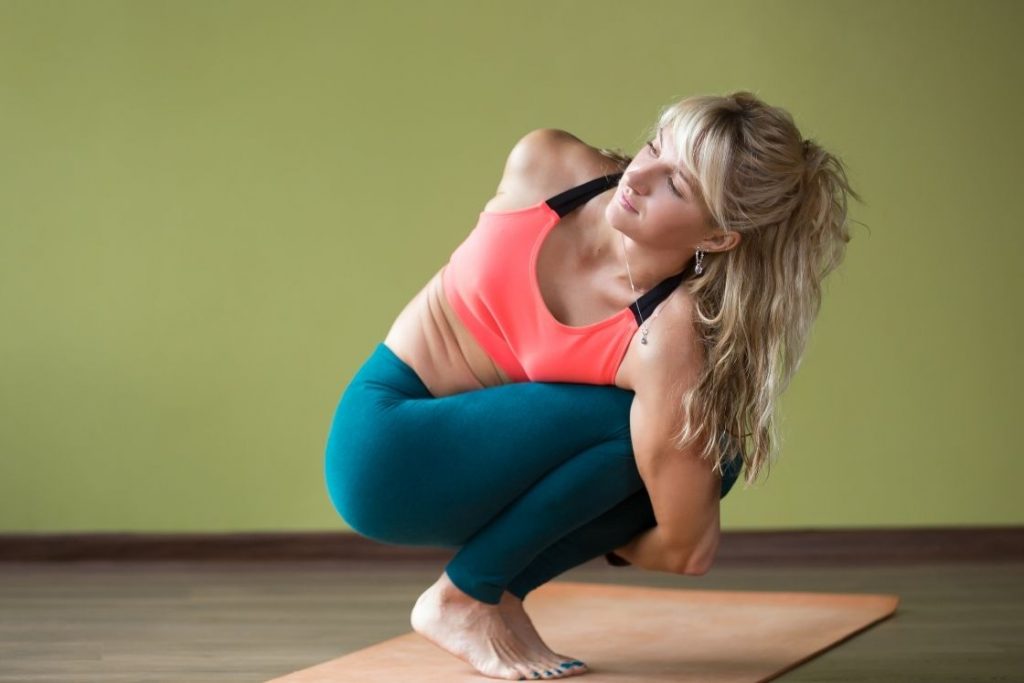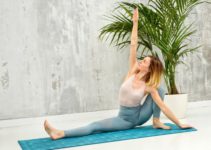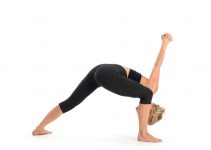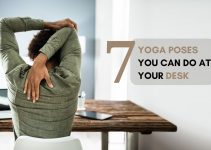
Pasasana is Ashtanga yoga intermediate series pose that is performed sitting on the feet. Anatomically it’s a quite challenging pose that involves balancing the body while maintaining a twist in a full squat.
In this posture, the entire body weight is on the feet and the squatted legs are swung slightly to one side. The torso is twisted opposite to the swinging direction. The arm respective to the swinging direction is wrapped around the shins and the other arm secures the loop by clasping the hands from behind.
The twist and stretches in noose pose target the muscles of the neck, shoulders, chest, groin, thighs, and ankles. It also works on the spine and core muscles.
Use the following guide to get into this deep and advanced pose easily.
Pasasana Meaning
In Sanskrit, ‘Pasa’ means ‘tie,’ or ‘noose’ and ‘Asana’ is ‘Pose.’ In this pose, the arms form a loop securing the knees and back in between. The arms are used in this posture as noose to hold the trunk to the legs, hence the name.
The pose requires balancing the body and stretches the muscle. This strengthens the engaging muscle and improves overall posture.
Pasasana Practice Guide

Precautions & Contraindications
- Do not let your heels lift off the floor by focusing on keeping them grounded.
- While squatting fully do not lose the foundation of the pose by bringing the buttocks to the floor.
- Be mindful while breathing throughout the posture.
- Avoid it with a lower back injury.
- Do not practice pasasana in case of a herniated disk.
- If you have a broken knee then it is not advisable to avoid the full squat.
- People with spondylitis or arthritis must not try pasasana.
Preparatory Poses
- Lord of the Fishes Pose (Ardha Matsyendrasana)
- Bound-Angle Pose (Baddha Konasana)
- Bharadvaja’s Twist (Bharadvajasana)
- Cow Face Pose (Gomukhasana)
- Garland Pose (Malasana)
How to Do Pasasana (Steps)
- Stand in tadasana.
- Come to a full squat bending your knees.
- Ensure to keep the heels grounded and sit entirely on your feet.
- Swing your knees slightly towards the left.
- Exhale twisting your torso towards the right and lower your left shoulder to the outer right knee.
- Keep your right hand on the floor and the left arm wrapped around both the shins reaches left outer thigh.
- Inhale, take your right arm from behind raising the right shoulder to clasp the left wrist.
- Lift your chin towards your shoulder and keep looking up.
- Keep breathing and hold the pose for 30 seconds.
- Exhale and release the twist coming back to the center.
- Repeat it to the left side.
- Release the hands and relax sitting on the mat.
Beginner’s Tips
- It is a challenging pose for every newbie. Don’t be hesitant to use pops (given below). Performing against the wall that is hands distant comes in handy the most. Try balancing the pose with one hand on the wall. As you find your balance bring the hands to be held by the hand wrapped around the shin and back.
Follow-up Poses
- Lord of the Fishes Pose (Ardha Matsyendrasana)
- Marichi’s Pose III (Marichyasana III)
Modifications
Use the following props to easily modify the noose pose.
- Blanket – Place a folded blanket under the heel if there is a gap between the floor and heel while maintaining the pose.
- Yoga blocks – Stack a few blocks one over the other. As you perform the squat you can rest your buttocks over the blocks. Adjust them as per your limit to go down.
- Against the wall – Perform pasasana against a wall. After coming down to the squat as you twist, you can bring your hands to the wall. It helps to balance the body while holding the posture.
Variations
Once mastered the basic noose pose, perform these variations to deepen the pose.
- Pasasana with one leg – Sit on your feet with buttocks over the heels. Your arms lie between your legs in front of you. Wrap your left arm from behind to rest your left hand over the right thigh. Now grab your left wrist with the right hand around your right shin, moving the right armpit towards the inner right knee. Rotate your head to look over the raised left shoulder.
- Twisted Toe-stand Squat – Perform a full squat. Lift your heel and balance on toes. Now twist from your torso to your right and move your left armpit beyond your right outer knee. This opens the chest to the right. Now join your hands in prayer pose pressing your chest looking over the right shoulder.
Pasasana Benefits
1. Strengthens the ankles
In pasasana as the entire body sits on the feet, it exerts pressure on the ankles that provides toned ankles. The muscles around the ankles are exercised and ankles become stronger.
Pasasana is very relaxing to the feet, especially for those persons who stand for long hours at work.
2. Stretches and improves flexibility
Pasasana also works on lengthening the spine and stretches the shoulders, thighs, and groin. The stretches in these regions expand the surrounding muscles and enhance flexibility.
3. Aids digestion
The twisting of the torso in pasasana massages the abdominal muscles stimulating the internal organs. This enhances the functioning of the digestive system.
It has therapeutic action on flatulence and indigestion.
4. Facilitates respiration
The twisting of the torso in noose pose shifts the upper body to one side, opening the chest and shoulders. It expands the lungs and enhances their breathing capacity.
It is also beneficial to prevent and cure respiratory disorders like asthma.
5. Increase blood circulation
This posture exerts pressure on the muscles and opens the chest cavity lifting the heart. It enhances the efficiency of the heart that leads to increased blood flow to the muscles leaving a healthy circulatory system.
6. Alleviates menstrual discomfort
Pasasana stretches the groins that stimulate the uterus and other reproductive organs. Therefore, it has relieving effects on menstrual cramps and discomfort.
7. Relieves pain
Pasasana also serves as a pain-relieving pose. It includes the expansion of the muscles and releases the trapped tension within them. Therefore, it relieves any pain around the neck, shoulders, and back.
This pose is recommended to cure sciatica.




